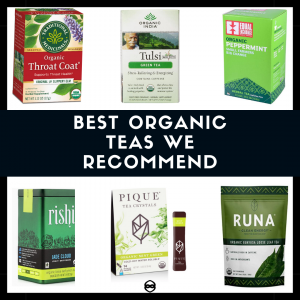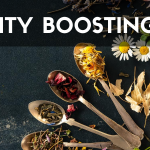What’s The Tea?
Episode 18 is here!
Show Description:
Did you know drinking tea has been considered a health-promoting habit since ancient times? Tea has been cultivated for thousands of years and its leaves have been used for medicinal purposes. This is just one of the many reasons why the EmPOWERment Couple has created a ritual celebrating the many powers of tea.
In this episode we are going to share all the juicy gossip sip by sip:
- How we started our tea ritual
- Why we recommend tea for your health
- 10 science-backed health studies
- How to select the healthiest teas
- Our top ten product selections
- The various types of tea out there
- Tools that will make your tea rituals easier
- We also play a game, and we have a special surprise for you that you don’t want to miss.
To spice things up, we will be giving away a delicious selection of teas to one of our randomly selected PodFam listeners, so make sure you register to participate. So, put on the kettle, pour yourself a comfy cup of your favorite tea, and join the EmPOWERment Couple in some hilarious and wholistic high jinks complete with an impromptu rap from D.J. Mikey and M.C. Z-Star!
Show Blog:
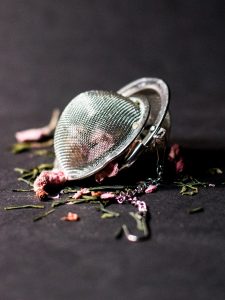 Tea drinking has been around for a long time and it’s one of the common bonds Mikey and I shared when we first met. We were both avid green tea drinkers and neither of us drank coffee at the time.
Tea drinking has been around for a long time and it’s one of the common bonds Mikey and I shared when we first met. We were both avid green tea drinkers and neither of us drank coffee at the time.
The first recording of tea was described as a “medicinal beverage” in China in the 3rd century AD. Merchants helped its popularity to spread quickly across continents. Later in the early 19th century, Great Britain popularized the afternoon tea and crumpets as a way to break up the afternoon.
Tea has such a dynamic history even in the U.S. Since we live close to Boston we have to mention that this tasty beverage has been steeped in colonialism, violence, and even in revolution.
Our Tea Ritual:
We began drinking tea in the mornings and afternoons. It wasn’t until I left my corporate position in 2012 that we decided to create a tea ceremony for mid-afternoon that we call “Taking Time For Tea.”
This ritual became a must after recognizing my very bad habit of making a hot cup of tea and then getting distracted, overloaded with work or clients or parenting, etc, and not drinking it. The ritual then turned into a time where we really committed to a no phone zone and sat somewhere in nature and drank tea together daily.
For us we found that it helped us:
- Connect and communicate
- Ground in nature
- Pause and be in the moment
- Catch up on the schedule for the week
- DISH the tea or current gossip
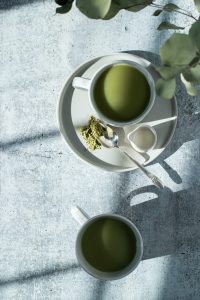 We realize, this is a luxury to do mid-day but it was deliberately designed once we decided to both work from home. So, yes, our ritual took place mid-afternoon because as Entrepreneurs we created our own schedule but this ritual can easily be done in the morning, evening, or anytime. Our existing tea ceremonies are in the afternoon, we call the afternoon ritual: Take Time For Tea and the evening: Tea and Tea Lights. We drink green tea in the afternoon and a calming night time tea at night. We have talked about tea drinking in our previous shows but in the context of moving your lymph and to aid a healthy night’s rest in our show Everybody Go Night Night. So let’s get into other reasons to drink tea.
We realize, this is a luxury to do mid-day but it was deliberately designed once we decided to both work from home. So, yes, our ritual took place mid-afternoon because as Entrepreneurs we created our own schedule but this ritual can easily be done in the morning, evening, or anytime. Our existing tea ceremonies are in the afternoon, we call the afternoon ritual: Take Time For Tea and the evening: Tea and Tea Lights. We drink green tea in the afternoon and a calming night time tea at night. We have talked about tea drinking in our previous shows but in the context of moving your lymph and to aid a healthy night’s rest in our show Everybody Go Night Night. So let’s get into other reasons to drink tea.
Why Drink Tea?:
Did you know drinking tea has been considered a health-promoting habit since ancient times? Tea has been cultivated for thousands of years and its leaves have been used for medicinal purposes. Tea consumption has also been shown to be useful for the prevention of many debilitating human diseases, and assist in the maintenance of cardiovascular and metabolic health. Various studies suggest that polyphenolic compounds present in green and black tea are associated with beneficial effects in the prevention of cardiovascular diseases, particularly of atherosclerosis and coronary heart disease.
Tea is Rich in:
- Polyphenols are micronutrients that we get through certain plant-based foods.
- Flavonols – specifically myricetin, quercetin, kaempferol. This is important to note because quercetin is a powerful supplement that works as an antioxidant in our bodies. It is also an ionophore for zinc which means it helps the body transport lipids through cell membranes. There are a lot of studies about flavonols, specifically quercetin because it is an immunity booster. We can recommend the quercetin to take along with the zinc we use. But, the good news is you can get it from tea!
- Theaflavins – formed when black tea leaves are oxidized
- Catechins – found in green tea; epigallocatechin-3 gallate (EGCG) is the main form. ECGC fights against free radicals that can contribute to cancer, heart disease, and clogged arteries.
- The other benefits are caffeine and theanine, which affect the brain and create more alertness.
It’s time we serve you a steamy cup of well-steeped facts.
 Here are 10 Science-backed Reasons That Support Tea Drinking:
Here are 10 Science-backed Reasons That Support Tea Drinking:
1. Drinking tea improves brain health. “A recent study led by researchers from the National University of Singapore revealed that regular tea drinkers have better-organized brain regions — and this is associated with healthy cognitive function — compared to non-tea drinkers.”
2. Drink tea because data supports the cancer-preventive effects of green and white tea. A study found one cup of green tea a day can reduce the chances of getting certain types of cancer. Another study showed that breast cancer specifically can be reduced by drinking green tea. Other research has found that green tea has a possible impact on liver, breast, prostate, and colorectal cancers. And even more, research shows that white tea may be the most effective tea in fighting various forms of cancer thanks to its high level of antioxidants.
3. Drink tea to assist in avoiding premature death, heart disease, stroke, and type 2 diabetes. “Observational research has found that tea consumption of 2-3 cups daily is associated with a reduced risk of premature death, heart disease, stroke, and type 2 diabetes.”
4. Drinking black, oolong, and green tea reduces blood pressure. Tea flavonoids may help to keep the lining of blood vessels smooth and elastic. In some studies, we found that regular long-term consumption of green, black, and oolong reduced the risk of developing hypertension.
5. Drinking tea helps manage cholesterol. Tea flavonoids have antioxidant properties that may prevent the oxidation of LDL cholesterol particles that could lead to inflammation and hardening of arteries.
6. Oral health benefits from regular tea drinking. Japanese researchers have found that tea can decrease tooth loss. Some research also points to White tea may also be good for your teeth since it contains a high source of catechins and tannins that can strengthen teeth, fight plaque, and make it more resistant to acid and sugar.
7. Tea supports immune boosting. Studies have shown tea can tune up immune cells so they reach their targets quicker. Holy basil or tulsi tea has been used by Ayurvedic practitioners for centuries to help keep the immune system strong after injuries or illnesses thanks to its antibacterial, anti-fungal, and anti-inflammatory properties.
8. Drink tea to support lung protection. Studies have shown that black tea may protect the lungs from damage caused by exposure to cigarette smoke. It also may reduce the risk of stroke.
9. Drink tea to support healthy weight loss. Certain studies are linking drinking green tea to weight loss. The studies examine the detoxing properties in green tea that aid fat loss. One animal study showed that animals given pu-erh tea, made from fermented and aged leaves. Considered a black tea had less weight gain.
10. Drinking tea prevents Alzheimer’s. Oolong tea is notable for containing l-theanine, an amino acid that reduces anxiety and increases alertness and attention. Scientists have found that l-theanine can help prevent cognitive diseases such as Parkinson’s and Alzheimer’s diseases.
Dirty Little Secrets on Tea:
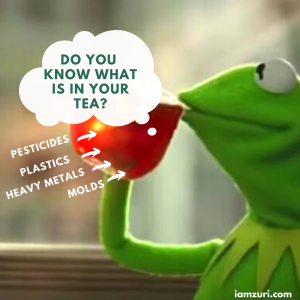 You might be thinking, “tea is tea” right? Wrong. Here is the real tea on tea. There are some important facts to share when it comes to selecting tea for regular consumption. In fact, it’s one of the things I always carry in my purse because I don’t want to drink tea that isn’t clean.
You might be thinking, “tea is tea” right? Wrong. Here is the real tea on tea. There are some important facts to share when it comes to selecting tea for regular consumption. In fact, it’s one of the things I always carry in my purse because I don’t want to drink tea that isn’t clean.
Why Organic Tea?:
In order to enjoy the benefits of drinking tea and getting the most out of this ritual, it’s important to note that drinking high-quality tea is a must. When following the declaration, “Let food be my medicine, and medicine by my food,” low-quality food equals low-quality medicine. This is also true with tea. I would go so far as to suggest, that if you are drinking tea, you should only drink organic tea. Why, well…
Here Are Five Reasons:
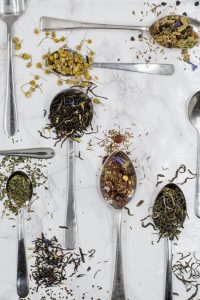 1. In 2012, a major study by Greenpeace found that the pesticide levels in Chinese teas are often very unhealthy. “All 18 samples contained at least three pesticides. One sample – Richun’s Tieguanyin 803 tea – even showed up with 17 different kinds of pesticides! A total of 14 samples were found to have the kind of pesticides that may affect fertility, harm an unborn child, or cause heritable genetic damage.”
1. In 2012, a major study by Greenpeace found that the pesticide levels in Chinese teas are often very unhealthy. “All 18 samples contained at least three pesticides. One sample – Richun’s Tieguanyin 803 tea – even showed up with 17 different kinds of pesticides! A total of 14 samples were found to have the kind of pesticides that may affect fertility, harm an unborn child, or cause heritable genetic damage.”
2. From the Spruce Eats: “Conventionally grown tea is one of the most environmentally devastating crops in Asia. Because it is often grown at higher elevations, the chemicals applied to conventional tea farms not only damage the local ecosystem but run down mountains and hills to wreak havoc on other farms, forests, rivers and even oceans located miles and miles away.”
3. Many conventional tea companies are adding GMO ingredients such as modified corn starch and soy lecithin under the labeling “artificial flavors.” GMOs are currently not required to be labeled in the U.S. These additives in tea are most likely made with genetically engineered corn and soy unless it is a non-GMO project verified or certified organic. Organic does not allow GMO ingredients. This is another reason to buy certified organic, non-GMO verified tea from companies that report where their tea was grown and how it is harvested.
4. A third-party analysis by Glaucus Research found that 91 percent of Celestial Seasonings tea tested, had pesticide residues. Buying certified organic tea is the only way to avoid persistent pesticides that can harm your health.
5. Research also tested one type of Teavana tea and found it contained 23 pesticides. In their research, they found that “77 percent of the teas would fail European Union pesticide import standards, and would be banned from import.” When we look at this study, another distinct number jumped out and that was of the teas tested, “62 percent contained traces of endosulfan, a pesticide that has been banned by the U.S., China, the E.U., and 144 other countries because it has been linked to impaired fertility and could harm unborn babies.”
Green, black and white tea are all made from leaves and if pesticides are applied directly to the leaves during the various stages of cultivation, then the chances of those same pesticides making their way into your cup significantly increase. Although a single cup won’t kill you, the cumulative effect of a chemical cocktail consumed daily will accumulate in your body over time and add to the toxic load that your body has to detox from. When toxins aren’t properly removed then they store in our bodies and then we become fat, sick, and diseased.
How To Choose Tea, Ask the Following 7 Questions:
1. Where was it grown?
Tested tea samples from China show high concentrations of heavy metals, pesticides, and plastics. Understanding the origin will help you determine what you’re investing in and what to look for. If you have a favorite tea and are unsure you can contact the manufacturer for more information.
2. How was it grown?
As we mentioned, conventionally grown tea uses high doses of pesticides and the very first time the tea leaves get washed is when they end up in your cup. Let me repeat that, pesticides used on tea are not washed off ever. You literally are drinking the pesticides if you are drinking conventional tea.
3. How is it stored?
Tea like many food products is prone to mold. “Fungal contamination of tea at any stage of commodity production can pose a serious health hazard due to the accumulation of toxic secondary metabolites of molds. The research revealed incidences of highly contaminated samples. Mold is something we should all be concerned with because mycotoxins are small, poisonous molecules, produced by certain species of molds.”
Mycotoxins can cause cancer, reproductive problems, liver and kidney damage, and reduced immune system response in both humans and animals. This brings us to our next question, was it tested for mold?
4. Was the final product tested?
Testing the final product is important because many of the pesticides used in conventional tea farming contain excess heavy metals, which not only show up in certain finished teas but also wash downstream to contaminate the soil and water elsewhere. You want to purchase a tea that has been tested for heavy metals, molds, and pesticides.
5. How is it being served?
- Loose leaf or bagged?
- Bleached bag or unbleached.
- Paper or plastic?
- Coated or uncoated?
- Sealed or stapled?
- GMO or non-GMO?
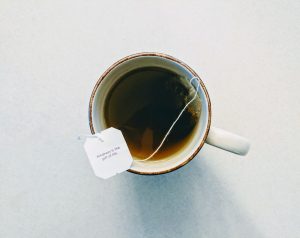 The concern about bagged tea boils down to this, certain brands use bags made of microplastics. The various types of bags include viscose PVC, thermoplastic, rayon, or polypropylene. The most common is PET, which stands for polyethylene terephthalate. Most plastic water bottles are made from PET. Plastics can disrupt your hormones and are linked to many health risks. In discussions of water bottles, it is well known that you don’t want to drink from a water bottle that has been in the sun all day. The reasoning is, plastic when heated can leach toxic chemicals into your bottled water and in this case, the same is true for tea.
The concern about bagged tea boils down to this, certain brands use bags made of microplastics. The various types of bags include viscose PVC, thermoplastic, rayon, or polypropylene. The most common is PET, which stands for polyethylene terephthalate. Most plastic water bottles are made from PET. Plastics can disrupt your hormones and are linked to many health risks. In discussions of water bottles, it is well known that you don’t want to drink from a water bottle that has been in the sun all day. The reasoning is, plastic when heated can leach toxic chemicals into your bottled water and in this case, the same is true for tea.
Another type of bag is PLA polylactic acid most commonly is derived from GMO corn reliant on the use of glyphosate. While the processing for PLA removes all traces of genetic material, it still supports Roundup Ready GMO crops. Glyphosate has been found at unsafe levels in tea. In particular, tea products showed 40–728 ppb in five samples.
The third type of bag is paper and many companies coat their paper mesh with a chemical called epichlorohydrin, which is an endocrine-disrupting chemical that has been classified as a carcinogen.
6. What is in the tea besides tea leaves? Artificial and natural flavors are extremely common additives because they create a cheap shortcut to add flavor to the actual ingredient. Artificial flavors are made to be addictive so if you are obsessively craving a product, it likely contains some artificial ingredients because they made that ingredient to be chemically addictive to humans.
The downside is artificial flavors are often made from petroleum.
Natural flavors can be derived from a number of things but they are rarely the ingredient you think you are buying. In fact, natural flavors can contain 2,300 possible substances.
Let’s be clear, natural and artificial flavors are added to a product to make you as the buyer get the taste they promised on the package. In some cases, they are meant to make you an addict to the product. For example, vanilla unless it says 100% organic vanilla extract, is oftentimes not vanilla at all, but actually something derived from wood pulp waste, coal tar, cow poop, secretions from a beaver’s anal glands, clove oil, pine bark, or fermented bran. Anyone care for beaver butt tea? I think not!
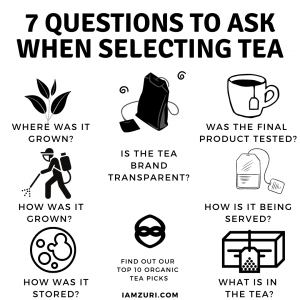 7. Is the tea brand transparent with their ingredients? If you have an allergy and you want to know an ingredient the brand should fully disclose how the natural flavors were derived. This is a common concern that comes up even when buying organic because natural flavors are allowed. For example, one of the worst offenders is Tazo tea, which is easily found at restaurants and coffee shops across the U.S. but even their organic varieties which I have had while traveling make me jittery and feel irritated. There is something they are adding to that tea or possibly the teabag that is causing a reaction but they don’t disclose all of the ingredients. Oftentimes, they don’t disclose this ingredient because they hide behind the words “proprietary blend.” You’ll notice this proprietary blend for flavors theme repeats itself even in the beauty care world with the word “fragrance.” But, I digress, the point is you as the buyer should know what you are buying. Period.
7. Is the tea brand transparent with their ingredients? If you have an allergy and you want to know an ingredient the brand should fully disclose how the natural flavors were derived. This is a common concern that comes up even when buying organic because natural flavors are allowed. For example, one of the worst offenders is Tazo tea, which is easily found at restaurants and coffee shops across the U.S. but even their organic varieties which I have had while traveling make me jittery and feel irritated. There is something they are adding to that tea or possibly the teabag that is causing a reaction but they don’t disclose all of the ingredients. Oftentimes, they don’t disclose this ingredient because they hide behind the words “proprietary blend.” You’ll notice this proprietary blend for flavors theme repeats itself even in the beauty care world with the word “fragrance.” But, I digress, the point is you as the buyer should know what you are buying. Period.
Our top 10 organic tea picks that passed our seven selection criteria with flying colors:
We are not affiliated with any of these brands. And rather than expect everyone listening to be a food investigator like Zuri, we’d like to empower you with the brands that will provide you with a safe and satisfying tea ritual.
1. Pique tea crystals are triple toxin screened for pesticides, heavy metals, and toxic mold. We drink their green tea and matcha. Tea crystals deliver concentrated polyphenols and are very convenient when traveling because there’s no steep time. You just blend and drink. They can be put in cold or hot water as well. Try a variety pack from Pique here. We also love their matcha but it is on the pricier side but truly with this product, you get what you pay for.
2. Traditional medicinals is our go-to for bagged tea. We highly recommend their Throat Coat tea for singers, speakers, and those with a sore throat. You can purchase that here. We also drink Nighty Night tea every night before bed and you can get that here.
3. Rishi is who we buy loose leaf from. We recommend this product from Rishi.
4. The Tea of Republic- (Stick with organic loose leaf and unflavored varieties). We drink their organic full leaf organic matcha. It’s one of the best tasting matcha powders. Get our recommended matcha here.
5. Organic India has so many great teas. Try their tulsi tea here.
6. Runa Organic Guayusa is delicious and will give you a strong but clean caffeine boost. Get their loose leaf tea here.
7. Choice Teas (avoid the few varieties that use natural flavoring) We drink the Choice Genmaicha Tea here.
8. Equal Exchange Teas are excellent. You cannot go wrong with their peppermint tea here.
9. Find a local organic herbalist that makes loose leaf teas, we love Emas Herbs from Ventura California where we both met and lived. She does ship if you don’t have a local favorite.
10. Pukka is a clean tea. Note: this brand uses some flavors but they are transparent and offer some products with clean ingredients. We like Pukka English Breakfast Tea here.
DIY: Make Your Own Tea Infusions
We like to grow our own tea ingredients and buy some bulk herbs to make tea infusions. Get some of our tea recipes here:
- Fresh Organic Mint Tea Recipe
- Organic Ginger and Turmeric Tea Recipe
- Organic Lemon Cayenne Tea Recipe
- Beautifying Rose Tea Recipe
- Organic Immunity-Boosting Tea Recipe
Making Your Tea Ritual Easier:
Usually, when we highlight the importance of quality the questions come rolling in about access and affordability. We are very sensitive to these issues as organic advocates and we always address the cheapest and best way to access the top quality products. The good news is we have some tricks to share for how to afford the best tea.
Thrive Market carries one of our favorite brands, Traditional Medicinals. You can get teas for $3 that are normally $5. Thrive Market is an online retailer that sells exclusively organic and natural foods and household goods at wholesale prices. With a Thrive Market membership, you can order your favorite health-food products for Costco prices and it gets delivered to your door as fast as Amazon Prime. What’s not to love about that? I order all of my pantry staples using their mobile app right from my iPhone and it saves me hundreds of dollars on organic food. And speaking of saving money, you can use my link to get a free 30-day trial and get 25% off membership using this link. 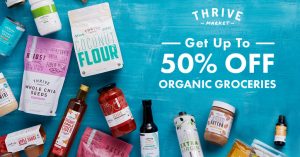 Buying tea in bulk will also help you save some money and get the best quality plus it reduces waste. Get a guide for growing your own tea.
Buying tea in bulk will also help you save some money and get the best quality plus it reduces waste. Get a guide for growing your own tea.
Grow Your Own: You can actually grow organic tea at home. Did you know the same plant can be used to make green, oolong, or black tea? This is the cheapest and healthiest way to get benefits from tea.
What’s The Tea Giveaway: We are offering a selection of our 10 favorite teas to one lucky winner selected randomly. The contest entries are very easy and you can enter in multiple ways.
Types of Tea:
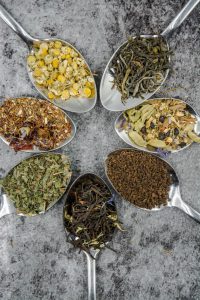 Under the definition of tea, you have tea made from leaves, tea made from flowers, tea made from roots, and tea made from a part of the fruit. In most cases, the targeted part of the plant is separated and dried. Once dried it is then processed and packaged. The consumer will then extract the plant’s medicinal gifts using hot water during the steeping process.
Under the definition of tea, you have tea made from leaves, tea made from flowers, tea made from roots, and tea made from a part of the fruit. In most cases, the targeted part of the plant is separated and dried. Once dried it is then processed and packaged. The consumer will then extract the plant’s medicinal gifts using hot water during the steeping process.
Black tea is the most popular worldwide, followed by green, oolong, and white tea. There are also, various other types of tea that you probably heard of:
- Herbal
- Mate
- Matcha
- Tulsi
- Kombucha tea. Fermented green tea with yeast and beneficial bacteria
Let’s also talk about some of the teas that you may not have heard of.
- Panda Dung tea, listed as the most expensive teas in the world, $3,000 for 50 grams. Green tea that is fertilized with Panda Dung
- Bug poop tea, tea that is fertilized using the bug droppings of bugs who only eat organic green tea leaves. The poop is harvested using a magnifying glass and tweezers.
- Garlic tea is good for the immune system, healthy metabolism, and a healthy heart.
Tea Temperature:
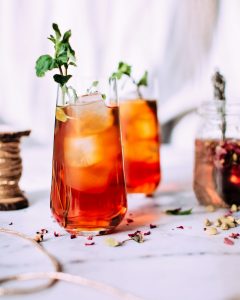 When it comes to tea, temperature matters. You want to be sure you steep your tea in the proper temperature. Each tea has a different temperature setting. Making tea with water that is too hot can burn the tea leaves.
When it comes to tea, temperature matters. You want to be sure you steep your tea in the proper temperature. Each tea has a different temperature setting. Making tea with water that is too hot can burn the tea leaves.
Did you know some evidence suggests that when you drink tea too hot it can result in damage to your esophagus and stomach? Carcinogenicity of drinking coffee, mate, and very hot beverages has been linked to esophageal and stomach cancers.
We provide a tea temperature guide in our show blog to help you keep all the beneficial properties of the tea while also keeping your stomach and throat safe.
Tea for different occasions
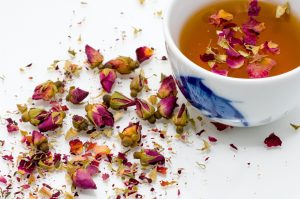 Tea leaves and herbs can create different sensations in the body. Caffeinated teas can provide similar boosts in energy whereas herbal teas can create a calming effect. Since this show isn’t about herbs we are going to focus on a few herbal tea ingredients to introduce when looking to change your state.
Tea leaves and herbs can create different sensations in the body. Caffeinated teas can provide similar boosts in energy whereas herbal teas can create a calming effect. Since this show isn’t about herbs we are going to focus on a few herbal tea ingredients to introduce when looking to change your state.
- Calm- Look for herbal teas that contain: Peppermint leaf, Lemon balm, Yarrow, Speedwell, Elderflower, Chamomile flower, Linden flower & leaf, Valerian root,
- Energy- Look for teas that are caffeinated or that contain: Blessed thistle, Alfalfa leaf, Damiana leaf, Strawberry leaf, Basil leaf, Gentian root, Yarrow, Rosemary leaf, Ginseng
- Ease Depression- St. Johns Wort, Peppermint, Lemon balm, Calamus root, Chamomile flower, Germander, Borage, Elderflower, Valerian root, Holy Basil, Basil, Rosemary
- Beauty- there are numerous teas that support skin health, gut health but one tea has been used for thousands of years to promote beauty and that’s rose tea.
- Immune boosting– Teas that have the herbs Linden flower, Peppermint, Elderflower, Restharrow, Rosehip, Chamomile leaf, Birch, Coltsfoot Echinacea leaf. There’s also a kitchen medicine tea that we make with orange peels, ginger, and garlic that is great for boosting the immune system.
- Cleansing– Drink detox herbs such as Dandelion leaf, Milk Thistle, Yarrow, Agrimony, Germander, Chamomile flower, Chicory root, Buckthorn bark, Peppermint leaf
Reading the tea leaves:
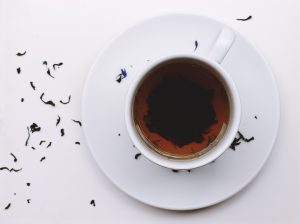 Did you know tea leaves are also used as a divination tool to explore the past, present, and future? It’s called tasseography. It’s been around for centuries and basically it is the art of identifying symbols and interpreting messages found in the configurations of tea leaves. It has been said that the leaves become energetic conduits when we focus our intention on finding the answer. The leaves are able to reveal hidden blockages, offer advice, and even forecast the future. We suggest using the book Reading Tea Leaves — written by “A Highland Seer” in 1881. Typically they say you see symbols: animals, mythical beings, objects, letters, and numbers. It gets very complex in what part of the cup the patterns are seen etc, but for fun let’s just see what we see. The best way to use this method is to ask it a simple, specific question.
Did you know tea leaves are also used as a divination tool to explore the past, present, and future? It’s called tasseography. It’s been around for centuries and basically it is the art of identifying symbols and interpreting messages found in the configurations of tea leaves. It has been said that the leaves become energetic conduits when we focus our intention on finding the answer. The leaves are able to reveal hidden blockages, offer advice, and even forecast the future. We suggest using the book Reading Tea Leaves — written by “A Highland Seer” in 1881. Typically they say you see symbols: animals, mythical beings, objects, letters, and numbers. It gets very complex in what part of the cup the patterns are seen etc, but for fun let’s just see what we see. The best way to use this method is to ask it a simple, specific question.
Tea Tools:
If you’re convinced you need to add tea drinking to your daily rituals we recommend the following:
- Electric Temperature Control Tea Kettle
- Electric Tea Frothers
- Matcha Tea Set
- Tea Strainer
- Zojirushi Travel Tea Canteen
- Tea Balls
We are so happy you chose to tune into and read our tasty What’s The Tea show blog. We’d love to see one of you win the What’s The Tea giveaway so be sure to enter here.
Cheers. Enjoy your spot of tea.


